

In July 2016, the lower portion of a valley glacier in the Aru Range of Tibet detached and barreled into a nearby valley, killing nine people and hundreds of animals. The huge avalanche, one of the largest scientists had ever seen, sent a tongue of debris spreading across 9 square kilometers (3 square miles). With debris reaching speeds of 140 kilometers (90 miles) per hour, the avalanche was remarkably fast for its size.
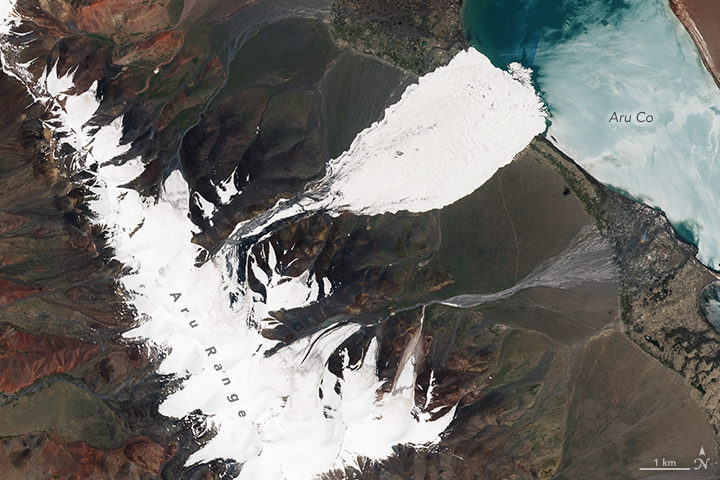
(NASA Earth Observatory image by Joshua Stevens, using modified Copernicus Sentinel 2 data processed by the European Space Agency. Image collected on July 21, 2016.)
Researchers were initially baffled about how it had happened. The glacier was on a nearly flat slope that was too shallow to cause avalanches, especially fast-moving ones. What’s more, the collapse happened at an elevation where permafrost was widespread; it should have securely anchored the glacier to the surface.
Two months later, it happened again — this time to a glacier just a few kilometers away. One gigantic avalanche was unusual; two in a row was unprecedented. The second collapse raised even more questions. Had an earthquake played a role in triggering them? Did climate change play a role? Should we expect more of these mega-avalanches?
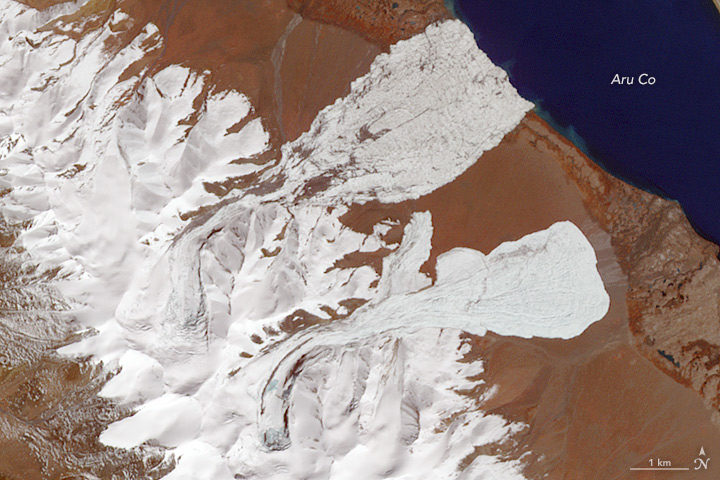
(NASA Earth Observatory image by Joshua Stevens and Jesse Allen, using ASTER data from NASA/GSFC/METI/ERSDAC/JAROS, and U.S./Japan ASTER Science Team. Image collected on October 4, 2016.)
Now scientists have answers about how these unusual avalanches happened. There were four factors that came together and triggered the collapses, an international team of researchers reported in Nature Geoscience. The scientists analyzed many types of satellite, meteorological, and seismic data to reach their conclusions. They also sent teams of researchers to investigate the avalanches in the field.
First, increasing snowfall since the mid-1990s caused snow to pile up and start working its way toward the front edge of the glaciers (a process known as surging). Second, a great deal of rain fell in the summer of 2016. As a result, water worked its way through crevasses on the surface and lubricated the undersides of the glaciers. Third, water pooled up underneath the glaciers, even as the edges remained frozen to the ground. Fourth, the glaciers sat on a fine-grained layer of siltstone and clay that became extremely slippery.
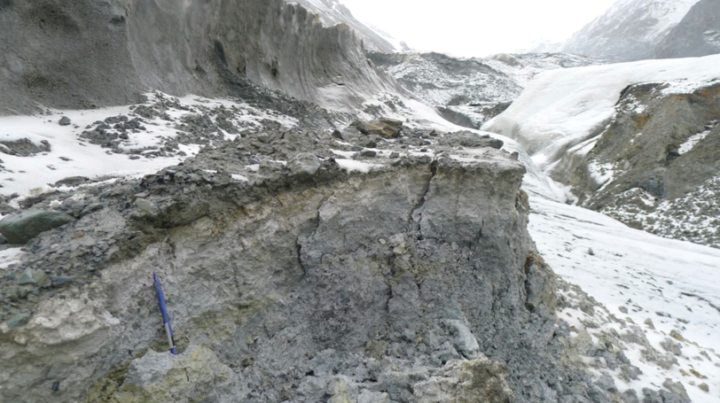
Notice the large amounts of silt and clay in the path of the first avalanche. (Photo taken on July 15, 2017, by Adrien Gilbert/University of Oslo)
Earth Observatory checked in with Andreas Kääb (University of Oslo), lead author of the study, to find out more about how the avalanche happened and what it means.
These glaciers were not on a steep slope, but the avalanche moved quite quickly. How did that happen?
Strong resistance by the frozen margins and tongues of the glaciers allowed the pressure to build instead of enabling them to adjust. The glaciers were loading up more and more pressure until the frozen margins suddenly failed. Local people reported a load bang. Once the margins failed, there was nothing at the glacier bed to hold it back, just water-soaked clay.
Your study notes that there was “undestroyed grassy vegetation on the lee side of the hills, suggesting that the fast-moving mass had partially jumped over it.” Are you saying the avalanche was airborne? If so, is that unusual?
Yes, for a small part of the avalanche path. We see this for other large-volume, high-speed avalanches, and it really illustrates the massive amount of energy released. You need quite high speeds in order for debris to jump. For us, the phenomenon is important as validation for the speeds obtained from the seismic signals the avalanches triggered and the avalanche modeling that we did.
Would you say these collapses were a product of climate change?
Climate change was necessary, but other factors that had nothing to do with climate were also critical. The increasing mass of the glaciers since the 1990s and the heavy rains and meltwater in 2016 are connected to climate change. The type of bedrock and the way the edges were frozen to the ground had nothing to do with climate change.
Can we expect to see more big glacial collapses as the world gets warmer?
It’s not clear. Climate change could increase or, maybe even more likely, decrease the probability of such massive collapses. Most glaciers on Earth are actually losing mass (not gaining, like the two glaciers in Tibet were). Also, if permafrost becomes less widespread over time and glacier margins melt, it is less likely that pressure will build up in that way that it did in this case.
I know you used several types of satellite data as part of this analysis. Can you mention a few that yielded particularly useful information?
We used a lot of different sources of data: Sentinel 1 and 2, TerraSAR-X/TanDEM-X, Planet Labs, and DigitalGlobe WorldView. Landsat 8 was absolutely critical because it gave the first and critical indication of the soft-bed characteristics. The entire Landsat series was instrumental for checking the glacier history since the 1980s. We also used declassified Corona data back to the 1960s.
Are these sorts of avalanches likely to happen in other parts of the world?
Honestly, I have no clue at the moment, but we would be much less surprised next time. We know now that this type of collapse can happen under special circumstances. (It happened once before in the Caucasus at Kolka Glacier.) One thing that should be investigated is whether there are other glaciers—especially polythermal ones—with these very fine-grained materials underneath them.
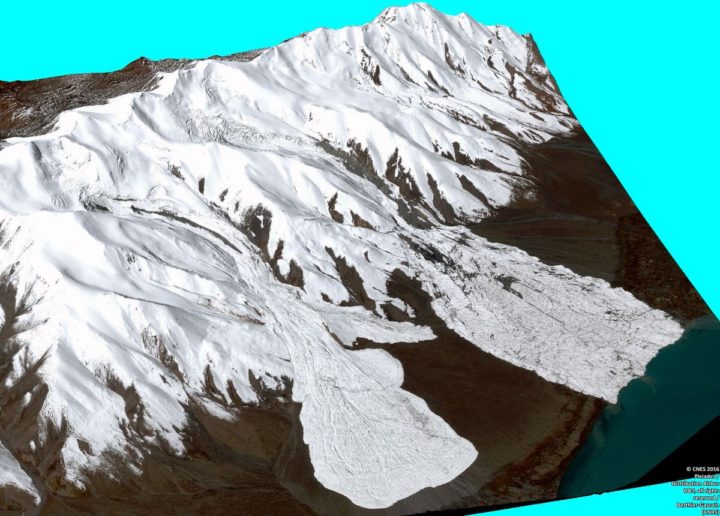
Three dimensional CNES Pléiades image of the avalanches. Processed by Etienne Berthier. Via Twitter.
With thousands of homes threatened by intense wildfires burning in southern California, NASA Earth Observatory checked in with Jet Propulsion Laboratory scientist Natasha Stavros to learn more about the destructive blazes.
Earth Observatory (EO): Why have these fires been so fast-moving and destructive? Are fierce Santa Ana winds the key factor? Are anomalous temperatures, rainfall, ENSO conditions, bark beetle activity, or other factors playing an important role?
There are absolutely other factors. Santa Ana winds definitely played a role in spreading the fires, but the late fire season is a more complex story. Last year, we had a lot of heavy rains, and this increased fuel connectivity by enabling grasses and annual shrubs to flourish (hence the green hills last spring). However, we had a lot of record-breaking heat waves this year.
In fact, a recent study we conducted with NASA DEVELOP and the National Park Service in the Santa Monica Mountains showed that the number of days over 95 degrees Fahrenheit stressed established vegetation and contributed to massive die-off. Even though the drought is over, the trees are still recovering from the stress of reduced water availability for such an extended period. They are in a fragile state and their defenses are down. This means that they are even more susceptible to infestation, mortality, and ultimately fire danger.
EO: We have published MODIS (top of the page), Sentinel-2 (below), and nighttime VIIRS (bottom of the page) satellite imagery of these fires. Is there anything that you find particularly interesting or notable about these images?
To me, the noteworthy thing is that the plume is going over the ocean and not the continental United States (as we saw earlier this year). This has to do with the Santa Ana winds coming from the desert and pushing particulates, ozone, carbon monoxide, and other toxic pollutants away from where people live.
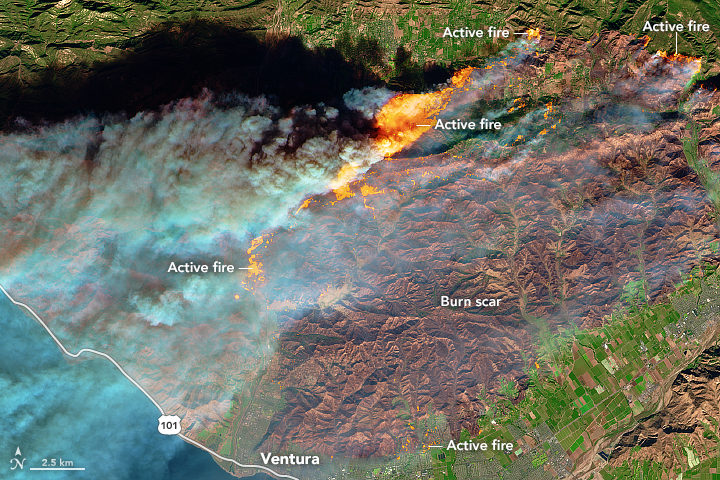
NASA Earth Observatory image by Joshua Stevens, using modified Copernicus Sentinel data (2017) processed by the European Space Agency.
As for the Sentinel-2 image, this is a great shot in that it really shows the value of remote sensing in monitoring fire. Flames that look like that are tens of meters tall. The flame length is proportional to the heat released from the flame, so these fires are very hot. Just like you would not want to stand too close to a bonfire with flames tens of meters tall, fire management does not want to put personnel in the path of those flames.
Images like these and fire behavior models help inform how we think the fire will move across the landscape. There is still a lot we do not know; our models are based on what we do know, so as fires become more intense, the models do not work as well, so this is an area of active research.
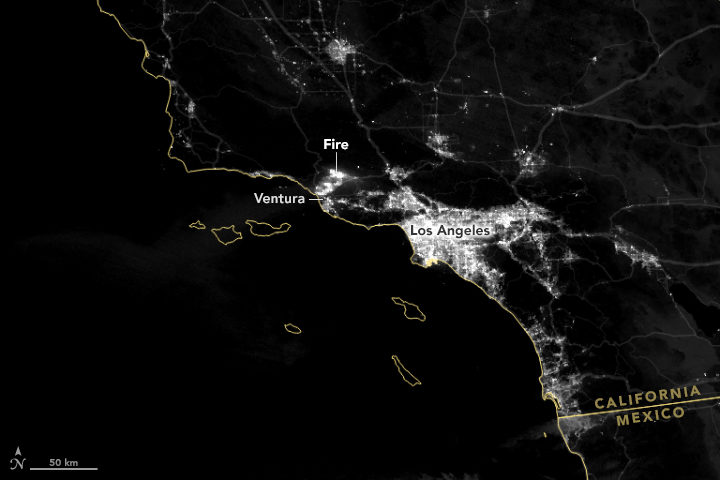
NASA Earth Observatory images by Joshua Stevens using VIIRS day-night band data from the Suomi National Polar-orbiting Partnership.
EO: Is there anything to say about how these fires fit into longer term trends and/or changing climate patterns?
Fire regimes are changing. There is no question about that, and there are a lot of things contributing to it: climate change, a century of fire exclusion, and a growing wildland urban interface (WUI). As we move into the future, we expect there to be an increase in very large fire events. Also, and this is relevant for the events happening now, there will be longer fire seasons. Also, note that many of the fires that ignite close to where people live are actually caused by people. This is particularly true in Southern California.
As we move forward, we need to think about how to support smart fire management practices. By that I mean: what can we proactively do to reduce fire risk (i.e. the threat to valuable resources)?
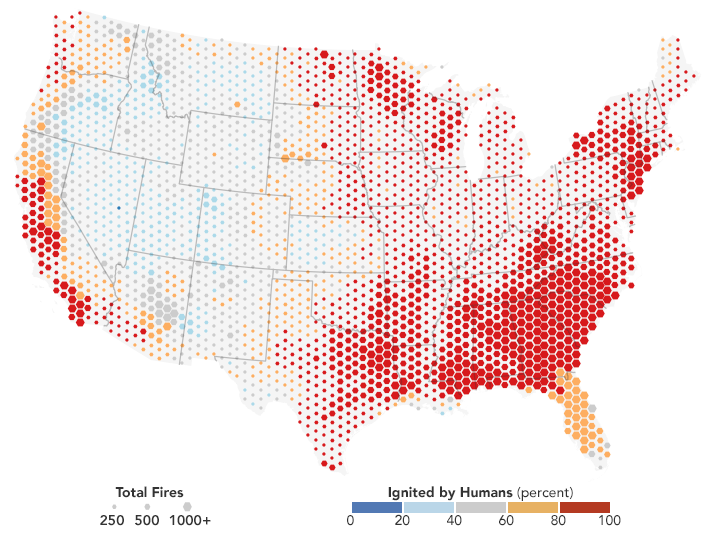
Most fires on the coasts are lit by people. NASA Earth Observatory map by Joshua Stevens, using fire data courtesy of Balch, J. et al. (2017).
EO: What about JPL’s response to these fires? I was intrigued by the megafire project described here. Will your group be responding to this fire in any way?
We just received approval from NASA Headquarters to fly the Airborne Visible/Infrared Imaging Spectrometer (AVIRIS) over these fires. This sensor has been useful for investigating fuel load type and subsequent effects on emission types, fire behavior, and post-fire analysis (e.g., safety, erosion, area burned, fire severity or the amount of environmental change caused the fire, etc.) and is often analyzed in interagency and federal-academic coordination to improve our understanding of fire.
Another effort to support fire management includes work being done from JPL in coordination with the National Interagency Fire Center (NIFC) to help them develop metrics of fire danger using NASA satellites that provide hydrologic variables (e.g., soil moisture and vapor pressure deficit—the difference between the amount of moisture in the air vs how much it can hold). These metrics have a one-month forecast to help allocate fire management resources nationally, which is particularly important as our fire seasons extend throughout the year in multiple places at the same time.
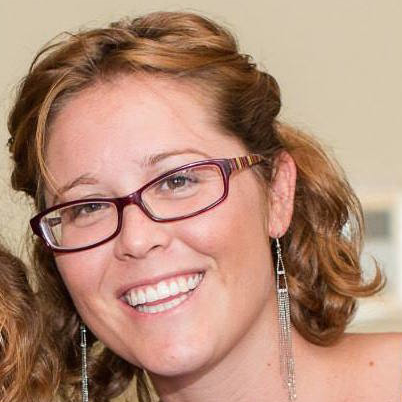
Natasha Stavros. Image courtesy of N. Stavros.

Image: NASA Earth Observatory/Joshua Stevens. Data courtesy of Hakkarainen, J., Ialongo, I., and Tamminen, J.
A reader recently wrote to ask us about our November 17 article: “Satellite Detects Human Contribution to Atmospheric CO2.”
“Hello, I read on the site that CO2 concentrations are higher in some areas and lower in others. Is the reason for this that the higher zones are near CO2 sources such as heavily populated areas? I always thought gas spread evenly in a container.”
We asked Janne Hakkarainen, a researcher at the Finnish Meteorological Institute and co-author of the study that used OCO-2 data to make satellite-based maps of human emissions of carbon dioxide. Launched in July 2014, NASA’s Orbiting Carbon Observatory-2 (OCO-2) was designed to give scientists comprehensive, global measurements of carbon dioxide in the atmosphere.
Hakkarainen wrote: “Carbon dioxide is indeed well mixed in the atmosphere. This means that if we look at the CO2 concentrations globally, the value is about 400 ppm everywhere.” (That’s 400 parts per million.)
Findings from the UN Intergovernmental Panel on Climate Change warn about the consequences of rising CO2 concentrations: “Any CO2 stabilisation target above 450 ppm is associated with a significant probability of triggering a large-scale climatic event.”
“In our recent research paper, we developed a methodology to derive regional CO2 anomalies, which means that we remove from individual CO2 values the regional CO2 median,” wrote Hakkarainen. “When these anomalies are averaged over time, the map highlights the CO2 signal that is not yet mixed and still close to the emission source. The idea is to average out the ‘CO2 weather’ or ‘transport,’ illustrated nicely in this NASA computer simulation (below).”
Another reader asked: “Can someone explain the high CO2 content over the Idaho panhandle and the large area at sea off the Oregon-California border.”
“The Idaho Panhandle anomalies could be related to biogenic sources or fire emissions,” wrote Hakkarainen. For example, NOAA’s CarbonTracker system showed positive fluxes (not including fossil fuel emissions) in that area in 2014.

Image: NASA Earth Observatory/Joshua Stevens. Data courtesy of Hakkarainen, J., Ialongo, I., and Tamminen, J.
Earth Matters occasionally publishes interviews with earth scientists from around NASA. Here we feature Santiago Gassó, research associate at Goddard Space Flight Center in Maryland.
What is most interesting about your role at Goddard?
I am a physicist and work in atmospheric science, with a specialty in remote sensing. I use data from satellites to look at Earth’s atmosphere, and I focus on natural and manmade aerosols, which are very small particulate matter.
I am part of the science team for the Ozone Monitoring Instrument (OMI) on the Aura satellite. Launched in 2004, OMI is an instrument designed to survey pollutants such as sulfur dioxide or aerosols in the atmosphere. I am part of the team that develops algorithms based on this data.

These scanning electron microscope images (not at the same scale) show the wide variety of aerosol shapes. From left to right: volcanic ash, pollen, sea salt, and soot. (Micrographs courtesy USGS, UMBC (Chere Petty), and Arizona State University (Peter Buseck).) The top strip of photos shows desert dust, volatile organic compounds from vegetation, smoke from forest fires, and volcanic ash. All are natural sources of aerosols. (Photographs copyright (left to right) Western Sahara Project, Jonathan Jessup, Vox, and Ludie Cochrane.)
Where are you from?
I was born in Buenos Aires, a city as dense as New York. I got a master’s degree in physics from the University of Buenos Aires. Because I wanted to live abroad, I came to the U.S. to get a doctorate in geophysics, specializing in atmospheric sciences at the University of Washington. I came to NASA Goddard because I wanted to learn radiative transfer theory from the people who designed and created the satellites that I used for my Ph.D. thesis. Radiative transfer is the study of propagation of electromagnetic energy. It provides the framework and, most importantly, the equations that most satellite retrieval algorithms use.
What is your main scientific work?
My main objective is to use algorithms to determine how much radiation has been absorbed by atmospheric aerosols. The study of absorption by aerosols is important because it can change the temperature profile of the atmosphere. For example, a thick cloud of smoke can increase the ambient temperature by absorbing solar energy and returning that energy to the environment as heat.
What are some of your other scientific interests?
I also like to spend time looking at satellite images for phenomena that are overlooked. For example, I am very interested in dust from glaciers and other high-latitude deserts. Dust plumes coming off Greenland’s and Alaska’s coasts can be clearly seen in satellite images.

The Moderate Resolution Imaging Spectroradiometer (MODIS) on NASA’s Aqua satellite captured this image of dust from the Copper River Delta being blown over the Gulf of Alaska on October 28, 2014. Read more here.
I am curious about measuring particulate mass concentration based on these images. The implication is that, unlike the more tropical sources of dust like the Sahara Desert, the high-latitude sources are near and upwind of ocean ecosystems with known deficiencies in certain nutrients. It is widely believed that the dust plumes are supplying nutrients, such as iron and phosphorous, that would otherwise not be available in these marine ecosystems. However, we have not yet proven this idea.
I am also beginning to work with astrobiologists to implement or adapt astrobiology remote sensing techniques to study aerosols in the Earth’s atmosphere. This is a new, exciting area for me.
What is your biggest discovery?
About 10 years ago, while looking at dust plumes coming off the Patagonia desert of South America, I ran into a very cloudy area with highly distinctive tracks in the clouds. It turns out that I discovered the equivalent of tracks of smoke from ship engines—except these tracks were generated by volcanoes. The tracks were formed in clouds moving over very weak volcanic eruptions. Rather than a full eruption, these traces are made from volcanic belches. When these aerosols reach the cloud deck above the volcano, they change the properties of the clouds slightly. Just like pollution entering a cloud, the volcanic aerosols induce a change in droplet size that results in a change in amount of radiation reflected by the cloud. This is change is what is detected by the satellite.
I found all this just by chasing dust from Patagonia. I just wanted to know how far this dust would go.
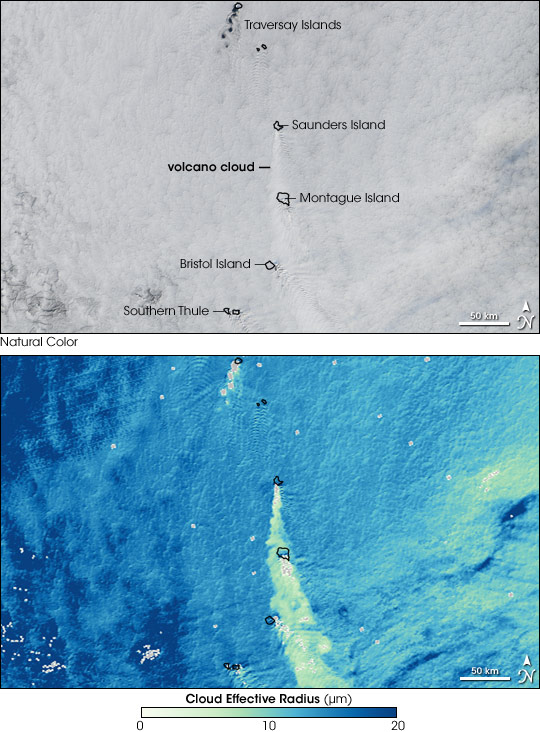
Clouds that form around volcanic emissions are made up of many small droplets instead of fewer larger droplets. Since these clouds present more surfaces for light to bounce off of, they are brighter than other marine clouds. Bright volcano clouds are similar to ship tracks, which from around sulfate aerosols in ship exhaust. The top image illustrates the impact of small-scale volcanic eruptions on clouds. The image was captured by the Moderate Resolution Imaging Spectroradiometer (MODIS) on NASA’s Aqua satellite on April 27, 2006. The lower image, calculated from the MODIS data, shows the average size of particles at the top of the clouds. Read more about the images here.
Please tell us about your field work in Patagonia.
I have been to Patagonia twice. Both times, I was working with a partner to install equipment that measures dust at the ground—the same dust that we see from space.
Patagonia is a desert in the southern end of Argentina. It is cold, dry, and sparsely populated. Patagonia lies next to a fantastic mountain range, the Andes, that is twice as tall as the Rockies.
How have your Patagonian studies evolved?
I was the first person to report observations from space of dust storms in Patagonia. I was the first one to study the entire transport of these dust storms using satellites and modeling tools.

The Moderate Resolution Imaging Spectroradiometer (MODIS) on NASA’s Aqua satellite captured this natural-color image of dust blowing out of the Patagonian Desert.
This work put me in touch with a diverse group of scientists–including geochemists, paleoclimatologists, and geomorphologists–who are all interested in the presence and impact of dust at high latitudes. We formed a network called the High Latitude Dust and Climate Network, and we are hosting a symposiumin Iceland two years from now.
It is interesting to see how different scientists view time. The satellite data I use is based on many photos per minute. My time reference is very fast. In contrast, some of the paleoclimatologists, who drill cores into the ice, view tens of thousands of years in a single inch. They think in terms of thousands of years.
How did your training make you able to find things no one else sees?
This skill comes from my Ph.D. thesis on measuring how atmospheric particles capture water and grow to become cloud drops. I was one of my adviser’s first Ph.D. students, and he did not have much money to buy new equipment. So we had to use observations or data already analyzed by other groups. As a result, I was always getting leftover data that had already been mined. The easy things that one could say about them had already been discovered and reported. So I had to sharpen my skills to discover phenomena and effects that had been overlooked by others.
What motivates your scientific research?
I am always curious about understanding physical concepts and how different phenomena integrate. For example, I want to understand how dust interacts with ocean biology. Another example is how the ocean interacts with the atmosphere by supplying aerosols.
What else do you do to satisfy your curiosity?
I make it a point to attend seminars outside my field. Presently, I am very interested in planetary exploration, so I go to many lectures. It is super fun, and I learn things that I can apply to my own research. I also read papers from outside my field so that I can learn about other areas.
Why did you choose your profession?
I wanted to be a biologist. I became a physicist because it was easier for me to understand equations than to memorize facts. Mathematics makes sense to me.
Who is the most inspiring person you have worked with at Goddard?
One of my thesis advisers was the Yoram Kauffman. He was a very intelligent and generous scientist–brilliant actually. He was very good at inspiring and encouraging others to explore their instincts, to ask why and then find out the answer. Yoram is the one who inspired me to follow up on the volcano discovery. When I first showed him the faint traces, he was so excited that he said that he could see the image on the front page of Science magazine. Coming from him, that meant everything to me. Unfortunately, he died about two months later.
What do you do in your spare time?
On weekends, I spend most of my time with my wife and two kids. Every spare minute during the week, I get onto my laptop and look at new satellite images, much to my wife’s chagrin.
This piece was adapted from an article originally published by Goddard Space Flight Center.

Oreopoulos explains cloud optical thickness in front of the NASA hyperwall. Photo courtesy of L. Oreopoulos
Earth Matters occasionally publishes interviews with NASA earth scientists from around the agency. Here we feature Lazaros Oreopoulos, chief of the Climate and Radiation Laboratory at Goddard Space Flight Center.
Can you describe your job?
I have three roles. For the last two-and-a-half years, I’ve been the chief of the Climate and Radiation Lab, so that makes me a first-line supervisor. I manage the affairs of the lab of about 70 people that I joined in 1997.
I’m also deputy project scientist of the Aqua mission. Aqua was launched in 2002 as part of the Earth Observing System missions. Aqua measures various atmospheric, land surface, ocean and ice properties.
My third role is as a scientist studying the interaction of clouds with atmospheric radiation. I use satellite observations to understand cloud properties explaining the role of clouds and climate. I’m also trying to improve cloud representation in global climate models.
Clouds are notoriously hard to study. They come in so many different shapes, sizes and internal structures. A major question is how clouds will impact future climate change, whether they will mitigate or enhance the rate of change. We don’t have a long enough record of how clouds may have changed over the years to help us answer this question. It is challenging to reconstruct the record backwards, but satellite observations are the best way to construct records from the recent past forward.

This map shows an average of all Aqua MODIS cloud observations between July 2002 and April 2015. Colors range from dark blue (no clouds) to light blue (some clouds) to white (frequent clouds). Read more about the image here. NASA Earth Observatory images by Jesse Allen and Kevin Ward, using data provided by the MODIS Atmosphere Science Team, NASA Goddard Space Flight Center.
What makes your lab unique?
Our lab is an international group of scientists with various backgrounds who are all top experts in their fields. Most of our civil servant scientists were not born in the U.S. Many of them came to Goddard via a complicated, difficult path. Some survived the dissolution of their countries’ governmental systems. Another lived through a civil war during his childhood. As a result, little problems don’t scare or phase them. Their strong character puts everything in perspective because they have been through much worse. It makes them persevere and be persistent. They are also very, very happy to be here with all the means available to do what they love.
Our winter party celebrating the new year has a strong international flavor. We have a potluck party where people bring dishes representing the cuisine of their home countries. The accompanying slideshow with photos from their travels or youth years is quite entertaining.
Our group really doesn’t think about ethnic differences; we understand that we live in an international environment and are always accepting of cultural differences. Our party is one more opportunity to share experiences and backgrounds.
How do you keep such an international group moving in the same direction?
We have a lot of strong personalities, which is an asset. We try to stay focused on the science and our overarching goal, which is to fulfill our mission. We won’t stop until we’ve accomplished our goal.

Montreal at night. This photograph was taken from the International Space Station by Expedition 26 crew. Read more about the image here.
Please tell us about your international background.
I have lived in four countries. I speak Greek, English, French and German.
I was born in a small Bavarian town in Germany close to the Austrian border near Salzburg. My parents were poor Greeks who immigrated in the ’60s seeking a better life. We returned to Greece when I started school. I went to Aristotle’s University in Thessaloniki, Greece, eventually majoring in physics. I then went to McGill University in Montreal, Canada, earning a doctorate in atmospheric sciences. A year later, I came to Goddard as an atmospheric scientist.
Living in four countries gave me a variety of experiences and professional interactions. Not only is my lab international, but the research and science communities at large are international as well.
I was always interested in the mysteries of weather. Every day changes fascinated me. Seasons intrigued me. As an undergraduate, I met some professors who were atmospheric scientists and they encouraged me to do extra work to delve deeper into the topic. I also thought that job prospects were better for an atmospheric scientist than for other disciplines in physics.

Lazaros Oreopoulos. Photo by W. Hrybyk (NASA).
What was your proudest moment at Goddard?
My proudest day was the day I was deemed worthy to lead a lab. I was excited and intimidated at the same time.
What do you do outside Goddard?
I like listening to indie rock music, which is contemporary rock outside the major label circuit. My combined physical and digital music collection exceeds 5,000 albums. I tried playing guitar, but wasn’t very good at it. I’m now encouraging my young son to learn for both of us.
As a mentor, what advice to you give?
Within my laboratory, I personally work with five young scientists who help advance my research projects. I urge them to be passionate about the science, come up with original ideas and work hard.
I also tell them it is very important to learn to communicate their science effectively. I advise them how to get their message across in their writing and oral presentations. You first have to believe in your research project, that’s the start of being appealing as a scientist. Not everyone is very charismatic, you either are or you’re not, but you can learn to overcome a charisma deficiency. Everyone can learn to effectively communicate their science. I try to teach them to be concise and highlight what is important. I encourage them, as well as others in my lab, to attend workshops on how to present and write better.
What is the one thing you would tell someone just starting their career at Goddard?
I’d tell them that they are in one of the best places in the world to work in science and engineering. I’d tell them to focus on the fun and exciting aspects of their work and not worry about small, daily issues. Minor problems don’t change the fact that we are at Goddard and lucky to have this opportunity. So, I’d remind them to always focus on the big picture and what matters most.
What is it like being married to another researcher?

This astronaut photograph shows much of the nation of Greece. The Peloponnese—home in ancient times to the city-state of Sparta—is the great peninsula separated from the mainland by the narrow isthmus of Corinth. Read more about this image here.
My wife is an M.D.-Ph.D. at the National Human Genome Research Institute of the National Institutes of Health. We occasionally discuss our respective research. Since we are both scientists, we understand each other’s work demands and that there will be periods of intense work where we need to support each other. We have one child still at home so we have to creatively juggle caring for him along with our other domestic responsibilities. Every year we struggle to find mutually available days to take a family vacation. My wife was also born in Greece, so we try to go back to Greece every year. We are glad to see that our son is also showing an inclination towards mathematics and science, but will of course let him choose his own path.
This interview was originally published by Goddard Space Flight Center.